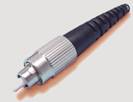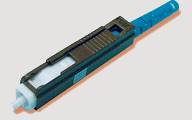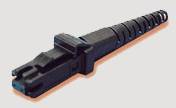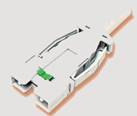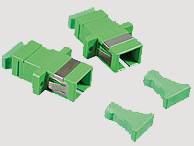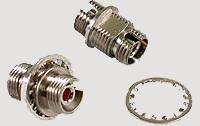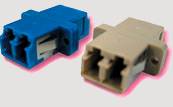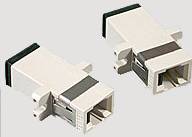1. What is Optical Fiber?
 |
An optical fiber (or fibre) is a glass or plastic fiber designed to guide light along its length. Fiber optics is the overlap of applied science and engineering concernedwith the design and application of optical fibers. Optical fibers are widely used in fiber-optic communication, which permits transmission over longer distances and at higher data rates than other forms of communications. Fibers are used instead of metal wires because signals travel along them with less loss, and they are immune to electromagnetic interference. Optical fibers are also used to form sensors, and in a variety of other applications.
2. What are the advantages of using Optical Fiber?
Low signal loss, high bandwidth properties are the main characteristics of fiber cable, they can be used over greater distances than copper cables, in data networks this can be as much as 2km without the use of repeaters. On a long distance line, there is an equipment hut every 4 to 6 meters. The hut contains equipment like spades and rakes that are used to pick up and retransmit the split signal down the next segment at full strength.
Their light weight and small size also make them ideal for applications where running copper cables would be impractical, and by using multiplexors one fibre could replace hundreds of copper cables. The real benefits in the data industry are its immunity to Electro Magnetic Interference (EMI).
Due to the fact that glass is not an electrical conductor and is non-conductive, it can be used where electrical isolation is needed, for instance between buildings where copper cables would require cross bonding to eliminate differences in earth potentials. Fibres also pose no threat in dangerous environments such as chemical plants where a spark could trigger an explosion. Last but not least is the security aspect, it is very, very difficult to tap into a fibre cable to read the data signals.
Further information on Copper Cables, please go to http://www.addison-tech.com
3. Common Fibre construction
There are many different types of fiber cable; in this FAQ we will deal with one of the most common types, 62.5/125 micron loose tube. The numbers represent the diameters of the fiber core and cladding, these are measured in microns which are millionths of a metre. Loose tube fiber cable can be indoor or outdoor, or both, the outdoor cables usually have the tube filled with gel to act as a moisture barrier which stops the ingress of water. The number of cores in one cable can be anywhere from 4 to 144.
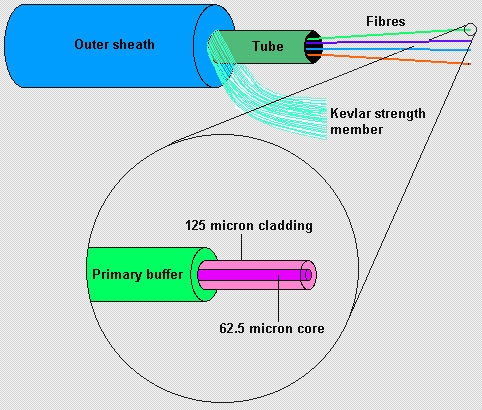
A variety of core sizes have been produced that are used in data communications. The 50/125 and 62.5/125 micron multi-mode cables are the most widely used in data networks, although recently the 62.5 has become the more popular choice.
The length limits for Gigabit Ethernet over 62.5/125 fiber has been reduced to around 220m, and now, using 8.3/125 may be the only choice for some campus size networks. Hopefully, this shift to single mode may start to bring the costs down.
4. Two basic cable designs
Loose-tube cable: used in the majority of outside-plant installations in North America.
Tight-buffered cable: primarily used inside buildings.

The modular design of loose-tube cables typically holds up to 12 fibers per buffer tube with a maximum per cable fiber count of more than 200 fibers. Loose-tube cables can be all-dielectric or optionally armored. The loose-tube design also helps in the identification and administration of fibers in the system.

Tight buffered cables are optimal for indoor applications. This design is suited for "jumper cables" which connect outside plant cables to terminal equipment, and also for linking various devices in a premises network. Being more robust than loose-tube cables, they are best suited for moderate length LAN or WAN connections, long indoor runs, direct burial, and for underwater use.
Rather than using the gel layer loose tube has, tight buffered cables have a two-layer coating. The first is plastic, and the other, waterproof acrylate. The acrylate keeps moisture away from the cable. The core is never exposed when bend or compressed underwater.
5. Principle of operation
There are two types of optical fiber: singlemode and multimode. Multimode fiber has a much larger core than SingleMode fiber, allowing hundreds of rays of light to propagate through the fiber simultaneously (High Order Mode). Multimode fiber may have a typical core diameter of 50 to 100 µm with a refractive index that is graded or stepped. It allows the use of inexpensive LED light sources and connector alignment and coupling is less critical than single mode fiber. Singlemode fiber, on the other hand, has a much smaller core that allows only one mode of light to propagate through the core (Low Order Mode). The fiber has a very small core diameter of approximately 8 µm. It permits signal transmission at extremely high bandwidth and allows very long transmission distances. It might appear that Multimode fibers have higher information carrying capacity, where the Singlemode fibers retain the integrity of each light pulse over longer distances, allowing more information to be transmitted. This high bandwidth has made Single Mode fiber the ideal transmission medium for many applications. Multimode fiber today is used primarily in premise applications, where transmission distances are less than two kilometers.

Single Mode Fiber

Multimode Fiber
6. Types of Cable
Breakout Cable

Breakout cables are designed with alldielectric construction to insure EMI immunity. It is basically several simplex fibers packaged individually inside one jacket. The design of the breakout-style cable adds strength to the cable,Breakout cable is suitable for riser and plenum applications such as routing within buildings, in riser shafts, and under computer room floors. The Breakout design enables the individual reinforced; you can divide the cable into individual fiber lines. In addition to the standard duty 2.4 mm subunit design, a 2.9 mm heavy duty and a 2.0 mm lite duty design are also available.
Interconnect Cable
Interconnect cable is use in dielectric construction and aims to provides EMI immunity. This type of cable is usually used as “jumper” for intra-building distribution. Interconnect Cable can be design in single mode and multimode fiber and this cable can be ordered for riser environments.
Lose Tube Cable

In loose-tube construction the fiber is laid helically into semi-rigid tubes, allowing the cable to stretch without stretching the fiber itself. This protects the fiber from tension during laying and due to temperature changes, therefore these are usually suitable for outdoor duct, aerial, and direct buried installations.
Low Smoke, Zero Halogen Cable
Low smoke zero halogen (LSZH or LSOH) is a type of cable jacketing used in the manufacture of industrial and network cabling. LSZH cable jacketing is composed of thermoplastic or thermoset compounds that emit limited smoke and no halogens when exposed to high sources of heat. It is designed to replace standard polyethylene jacketed fiber optic cables in environments where public safety is of great concern.
Most network cables are insulated with PVC plastic. In fires, this plastic material releases chlorine, a poisonous gas, which forms caustic hydrochloric acid when it comes in contact with water. Halogen-free cable, on the other hand, is made of a different material called polypropylene, which doesn't produce a dangerous gas/acid combination.
Low smoke zero halogen cable reduces the amount of toxic and corrosive gases emitted during combustion. Typically used in poorly ventilated areas, low smoke zero halogen is becoming very popular where the protection of people and equipment from toxic and corrosive gasses is critical.
Low smoke zero halogen cable is available with any optical fibers, both singlemode and multimode, in loose tube, tight buffer or breakout constructions. Attenuations as low as 0.4 dB/km, and bandwidths as high as 1000 MHZ/km, can be supplied.
LXE Light Guide Express Entry Cable
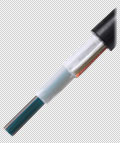
The LXE (Lightguide Express Entry) sheath system is designed with the loop distribution market in mind, where express entry (accessing fibers in the middle of a cable span) is a common practice.
The LXE sheath system achieves a 600 pound (2670 N) tensile rating through the use of linearly applied strength members placed 180 degrees opposite each other.
High density polyethylene (HDPE) is used for the cable jacket to provide both faster installation, through a lower coefficient of friction, and optimum cable core protection in hostile environments.
LXE Light Guide Express Entry Cable is the standard Non-Metallic (Dielectric) Lightguide Express Entry (LXE) cable, containing Multimode fiber.
Lightpack Cable
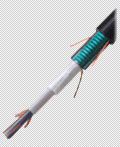
A cable core design that allows bundles of optical fibers in a cable core without central strength members. The LightPack cable features an easy-to-install, compact design that protects your network in outside plant environments. The LightPack cable core is a bundle of 2 to 12 fibers (up to 8 bundles, 96 fibers) held together loosely with two helically applied binders. Positive identification of each fiber is provided by color coding both the fibers and the binders.
Indoor/Outdoor Loose Tube Cable
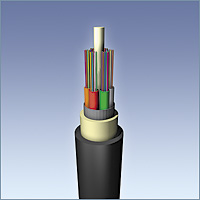
Indoor/outdoor stranded loose tube combines the robust mechanical and environmental characteristics of an outside plant cable with the flexibility of an inside plant riser cable. They meet or exceed Article 770 of the NEC and UL Subject 1666 (Type OFNR). They also meet CSA C22.2 No. 232M1988 Type OFNFT4.
All of the RLT products utilize a proprietary ChromaTek 3 jacketing system that is designed for resistance to moisture, sunlight and flame for use both indoors and outdoors By installing indoor/outdoor stranded loose tube, costly splice locations entering into a building are avoided, being routed directly from the outside plant to telecommunications closets, or main distribution frames (MDF) through the riser of a building and eliminating the “50-foot rule.”
Main Features:
- Building interconnections
- Telecommunications and data trunk
- Long haul networking
- Direct burial and aerial lashing
- Applications requiring good ozone, moisture, weather resistance
Tactical/Military Cable
Tactical cable utilizes a tight buffer configuration in an all dielectric construction. The tight buffer design offers increased ruggedness, ease of handling and connectorization. Tactical fiber optic cable designed to be quickly deployed across the ground for communications in battlefield conditions - can survive being run over by tanks, trucks and armored Humvees.
Simplex and Zip Cord
Simplex cables are one fiber, tight-buffered (coated with a 900 micron buffer over the primary buffer coating) with Kevlar (aramid fiber) strength members and jacketed for indoor use. The jacket is usually 3mm (1/8 in.) diameter. Zipcord is simply two of these joined with a thin web. It's used mostly for patch cord and backplane applications, but zipcord can also be used for desktop connections.
Distribution Cables
They contain several tight-buffered fibers bundled under the same jacket with Kevlar strength members and sometimes fiberglass rod reinforcement to stiffen the cable and prevent kinking. These cables are small in size, and used for short, dry conduit runs, riser and plenum applications. The fibers are double buffered and can be directly terminated, but because their fibers are not individually reinforced, these cables need to be broken out with a "breakout box" or terminated inside a patch panel or junction box.
Ribbon Cable
This cable offers the highest packing density, since all the fibers are laid out in rows, typically of 12 fibers, and laid on top of each other. This way 144 fibers only has a cross section of about 1/4 inch or 6 mm! Some cable designs use a "slotted core" with up to 6 of these 144 fiber ribbon assemblies for 864 fibers in one cable! Since it's outside plant cable, it's gel-filled for water blocking.
Armored Cable
Cable installed by direct burial in areas where rodents are problems usually have metal armoring between two jackets to prevent rodent penetration. This means the cable is conductive, so it must be grounded properly.
Aerial cable
Aerial cables are for outside installation on poles. They can be lashed to a messenger or another cable (common in CATV) or have metal or aramid strength members to make them self supporting.
7. Cable Design Criteria
Pulling Strength: Some cable is simply laid into cable trays or ditches, therefore pull strength is not too important. But other cable may be pulled thorough 2 km or more of conduit. Even with lots of cable lubricant, pulling tension can be high. Most cables get their strength from an aramid fiber, a unique polymer fiber that is very strong but does not stretch - so pulling on it will not stress the other components in the cable. The simplest simplex cable has pull strength of 100-200 pounds, while outside plant cable may have a specification of over 800 pounds.
Water Protection: Every outdoor cable must be protected from water or moisture. It starts with a moisture resistant jacket, usually PE (polyethylene), and a filling of water-blocking material. The usual way is to flood the cable with a water-blocking gel. It's effective but messy - requiring a gel remover. A newer alternative is dry water blocking using a miracle powder - the stuff developed to absorb moisture in disposable diapers. Check with your cable supplier to see if they offer it.
Fire Code Ratings: Every cable installed indoors must meet fire codes. That means the jacket must be rated for fire resistance, with ratings for general use, riser (a vertical cable feeds flames more than horizontal) and plenum (for installation in air-handling areas. Most indoor cables us PVC (polyvinyl chloride) jacketing for fire retardant.
8. Types of Connectors & Adaptors
There are many types of connectorsand adaptor. Choosing which one to use is usually decided by the type of connector already installed in the equipment to be connected.
When deciding upon the proper cable to use, there are only three issues to consider.
- Is it compatible with my equipment?
- Will I be using it in extremely hazardous conditions?
- Does it require special clearance?
Connectors
SC, ST, & LC Connectors are pre-polished, field installable connectors that eliminate the need for hand polishing in the field .Addison fiber optic connectors provide an immediate termination to either single-mode or multimode fibers.
|
||||||||||||||
|
||||||||||||||
|
||||||||||||||
|
||||||||||||||
|
FDDI Connector |
|||||||||||||
Used for networking applications. Duplex connector with fixed shroud, keyed. |
||||||||||||||
|
|
|||||||||||||
|
SMA Connector |
|||||||||||||
The SMA fiber connector is decreasing in popularity. |
||||||||||||||
|
|
|||||||||||||
|
D4 Connector |
|||||||||||||
Same as SMA Connector, it is decreasing in usage. |
||||||||||||||
|
|
|||||||||||||
Adaptors
Used to mate industry standard connectors, adapters are available with metal and ceramic alignment sleeves, and are color coded for easy identification. It is available in SC, FC, ST, LC, MU, MT-RJ, MTP & Hybrid.
|
|||||||
|
|||||||
|
|||||||
|
|||||||
|
|||||||
9. OM1 vs OM2 vs OM3
Multi-mode fibers are described using a system of classification determined by the ISO 11801 standard — OM1, OM2, and OM3 — which is based on the bandwidth of the multi-mode fiber.
For many years 62.5/125 µm (OM1) and conventional 50/125 µm multi-mode fiber (OM2) were widely deployed in premises applications. These fibers easily support applications ranging from Ethernet (10 Mbit/s) to Gigabit Ethernet (1 Gbit/s) and, because of their relatively large core size, were ideal for use with LED transmitters. Newer deployments often use laser-optimized 50/125 µm multi-mode fiber (OM3). Fibers that meet this designation provide sufficient bandwidth to support 10 Gigabit Ethernet up to 300 meters. Optical fiber manufacturers have greatly refined their manufacturing process since that standard was issued and cables can be made that support 10 GbE up to 550 meters. Laser optimized multi-mode fiber (LOMMF) is designed for use with 850 nm VCSELs.
The migration to LOMMF/OM3 has occurred as users upgrade to higher speed networks. LEDs have a maximum modulation rate of 622 Mbit/s because they can not be turned on/off fast enough to support higher bandwidth applications. VCSELs are capable of modulation over 10 Gbit/s and are used in many high speed networks.
Cabling System Name |
Fiber Type |
Connector Type |
Cable Type (Premises, + fiber count) |
OM3 |
OM3 - 50/125 laser optimized |
OM3 - (default LC) |
Zipcord |
OM2 |
OM2 - 50/125 |
OM2/ST - ST connector |
Same |
OM1 |
OM1 - 62.5/125 |
OM1/ST - ST connector |
Same |
10. Do signals really travel faster in fiber optical?
You might be surprised to know that signals in UTP (unshielded twisted pair) cables like Cat 5e travel at about the same speed (2/3 C) as in fiber optical. Coax, meanwhile, has a faster NVP (nominal velocity of propagation), about 0.9C, due to its design. Fiber's "speed" is not referring to the speed of the signal in the fiber, but the bandwidth potential of the fiber.
11. What is the distance Limitation on 100Mbps Fiber for Single Mode and Multi Mode?
Multimode 100 Mb/s (FDDI or Fast Ethernet) is limited to 2 km (1.2 miles) by the dispersion of the fiber and the chromatic dispersion limits of the LED in the fiber. This holds for both 62.5/125 micron fiber and 50/125 which exists in some older installations. Single mode links are avaialble for over 20 km (12 miles) or more. All single mode fiber for 1310 nm is the same, with a core diameter of about 8-9 microns and cladding diameter of 125 microns.
12. What is optical return loss?
For optical fibers, the loss typically happens at discontinuities of refractive index, such as splices or at an air-glass interface such as a fiber endface. This causes a fraction of the optical signal to be reflected back toward the source. The amount of reflection is determined by the Fresnel equations.
Fiber optic transmission systems often use lasers to transmit signals over optical fiber. These can be sensitive to light returning into the component. A high optical return loss (ORL) can cause the laser to stop transmitting correctly.
The measurement of ORL is becoming more important in the characterization of optical networks as the use of wavelength-division multiplexing increases. These systems use lasers that have a lower tolerance for ORL, and introduce elements into the network that are located in close proximity to the laser

